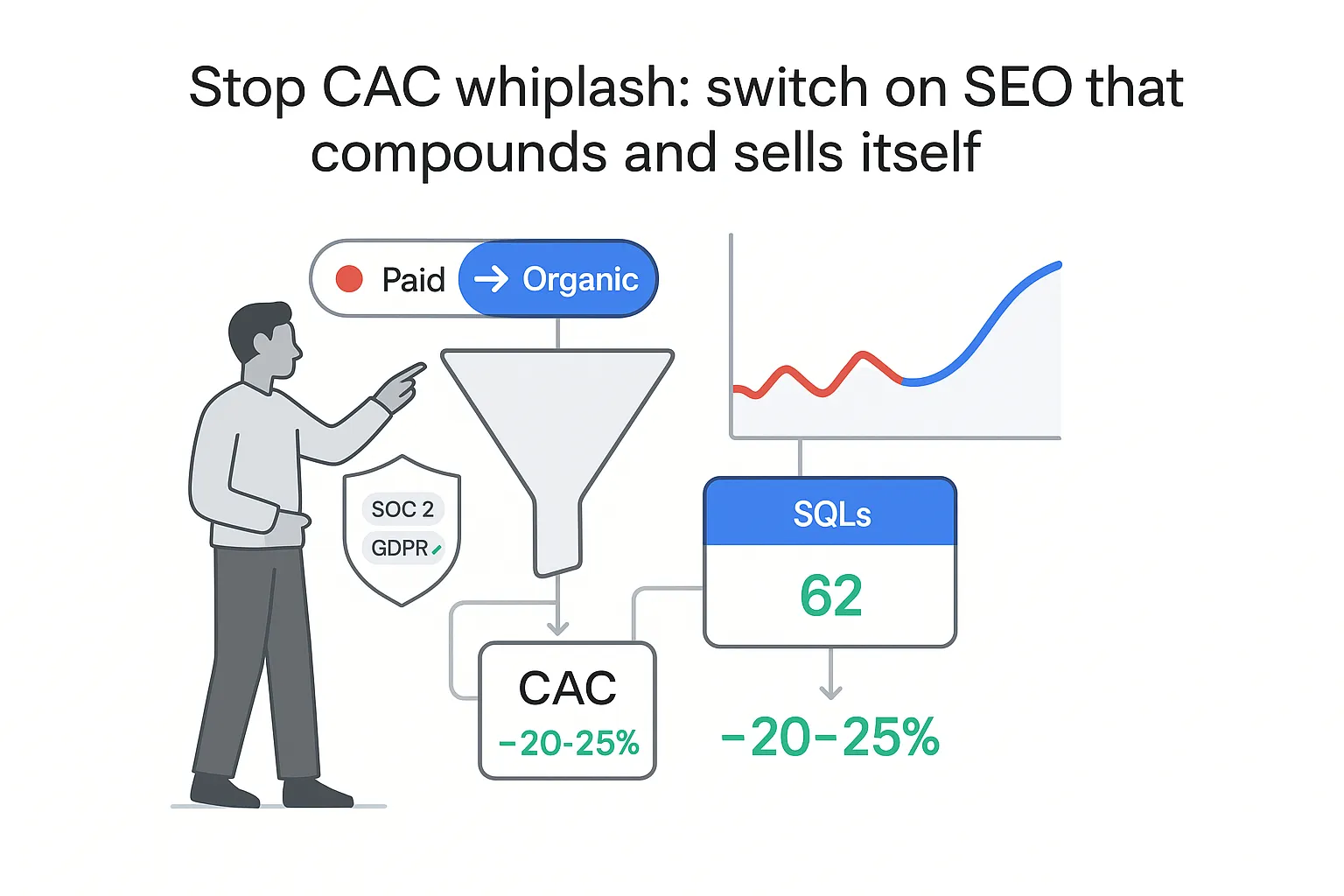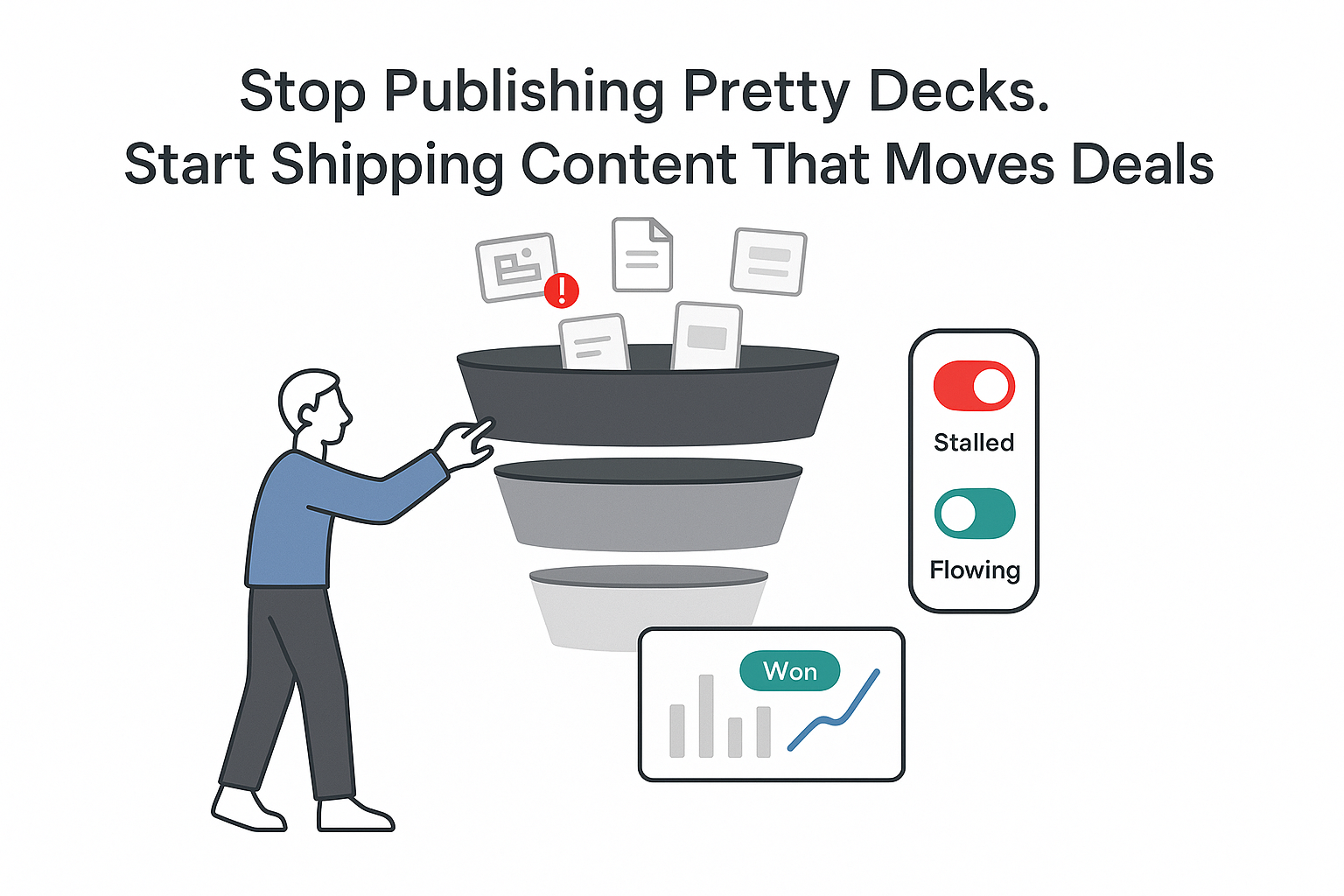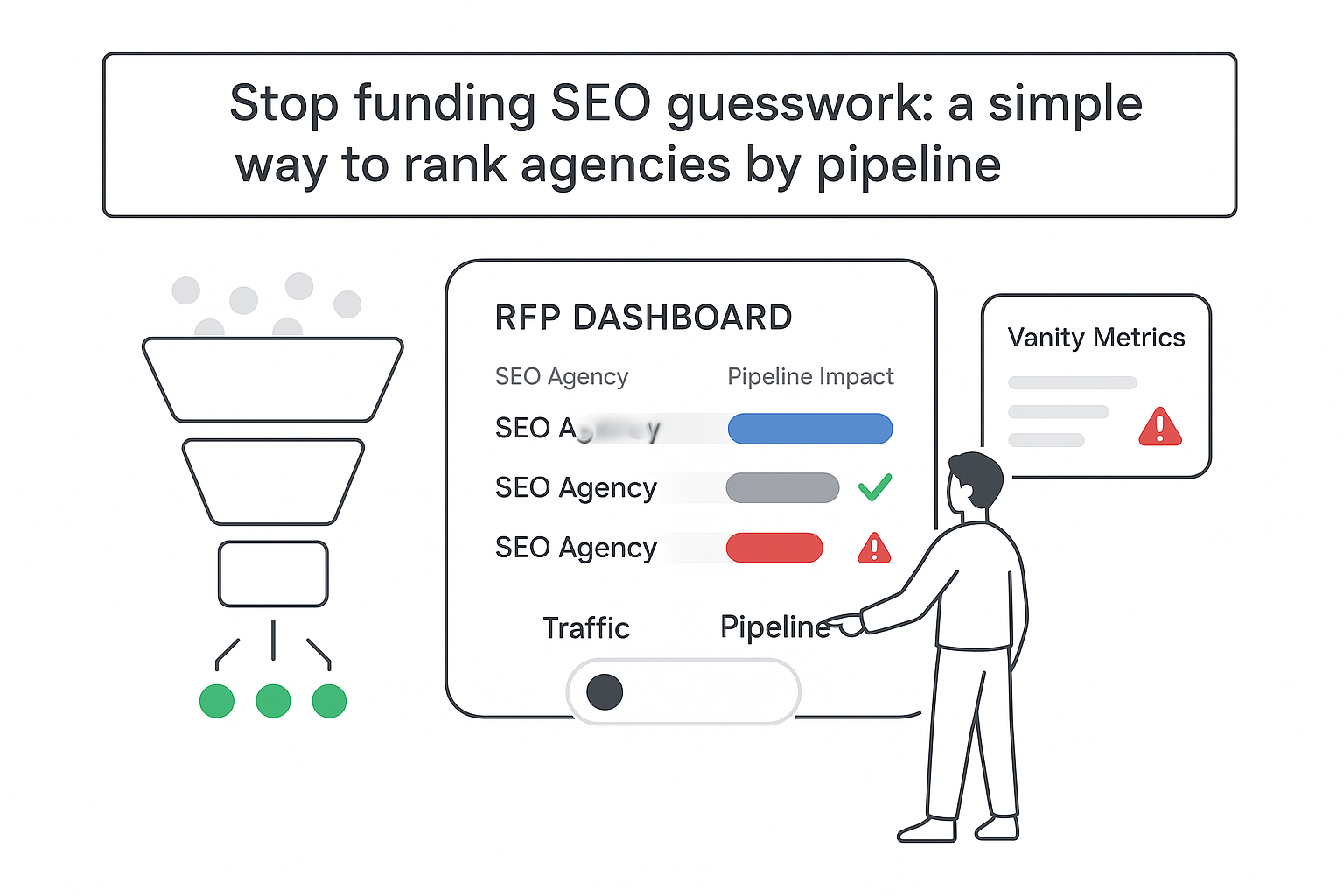If you run a B2B service company and feel stuck juggling paid channels, pipeline swings, and pressure on gross margins, you are not alone. The fix is not a silver bullet - it's a steady, accountable program that compounds. The target is predictable inbound and a sane blended CAC. Traffic is a proxy, not the prize. I treat SEO as a revenue lever and judge it by qualified meetings, proposals, and opportunities sourced - not vanity charts.
What predictable B2B SEO looks like
Predictable inbound and lower CAC are the point. I set revenue goals, map traffic to pipeline math, and report wins in plain English because finance cares about SQLs and revenue, not impressions. Benchmarks to calibrate expectations (ranges depend on domain history, content velocity, and sales capacity):
- 40–80% lift in qualified organic leads within 90–120 days when the team refreshes existing content, ships bottom-funnel pages, and resolves critical technical gaps
- 20–35% reduction in blended CAC over two quarters as organic replaces a slice of paid discovery
- 2–3.5× growth in organic-sourced pipeline in 6–9 months with consistent content and technical cleanup
These are directional, not guarantees. Baselines, seasonality, market shifts, and capacity to follow up on demand all matter. For timing and ROI clarity, I expect first movement in weeks on a domain with history. Sustainable gains tend to show by month three and compound from months six to twelve. For external context on CAC and SEO compounding, industry reports from firms like FirstPageSage and Conductor are useful benchmarks.
What B2B service leaders should demand
Social proof should say more than trusted by many. If you sell IT services, consulting, logistics, staffing, compliance, or SaaS-adjacent services, you manage long cycles and committee buys. That means your SEO program (whether in-house or via a partner) must support governance and handle the realities of procurement.
Security and compliance should be routine, not an exception:
- Documented controls aligned to SOC 2 Type II expectations
- GDPR-ready data handling and retention policies
- Role-based access, scoped credentials, and audit logs
Sample outcomes across B2B service segments (illustrative patterns I have seen in typical programs where prerequisites existed):
- IT managed services: refreshed solution pages and service comparisons drove a 58% increase in demo-qualified leads in four months
- Logistics and 3PL: technical fixes halved page load times, contributing to 35% more organic traffic and a 24% higher conversion rate to quote requests
- Professional services: research-backed pillar pages earned high-authority links and a 3.2× bump in organic pipeline within two quarters
Different industries, same theme: clear intent content, clean tech, and steady authority signals drive qualified demand.
Use cases that map to the sales cycle
Each use case should tie to a stage of your sales cycle. I align awareness for executives, consideration for procurement, and conversion for buyers who already want a short list - and I attach KPIs your finance team cares about.
Three common patterns:
- Pain: Paid search is getting pricey. Traffic is high, SQLs are not. Solution: bottom-funnel clusters and comparison pages. KPI: SQL rate from organic rises 30–60%.
- Pain: Complex services confuse visitors. Solution: information architecture and service navigation redesign. KPI: exit rate on core service pages drops 15–25% and time on page increases.
- Pain: No authority with execs. Solution: original research, benchmarks, and digital PR. KPI: 50–200 relevant referring domains and a rise in branded search volume.
Workhorse page types for lead generation:
- Intent pages for each service and vertical
- Comparison and alternative pages for buyers weighing vendors
- Bottom-funnel clusters around pricing, implementation, and security questions
Keyword themes that tend to ship SQLs:
- "[service] pricing," "[service] for [industry]," "[service] vs [category alternative]," "[vendor] alternatives," "[service] implementation"
- Problem language such as "reduce churn in [industry]," "switch from [legacy process]," "audit [compliance topic]"
A quick micro example from a typical B2B motion: a consulting firm added four comparison pages, two pricing explainers, and one implementation guide. Organic demo requests rose 49% over 10 weeks. Nothing fancy - just pages mapped to late-stage queries. Your mileage will vary based on authority, competition, and sales follow-up.
Enterprise SEO, without the surprises
If your site spans many services, regions, and roles, small mistakes compound. Enterprise SEO needs clean architecture, speed, and governance that sticks. Procurement wants proof of trust and clarity on who owns which risk.
What matters most:
- Crawl and index control through disciplined sitemaps, robots rules, canonicals, and pagination cleanup
- Speed wins that address Core Web Vitals, image discipline, caching, and CDN configuration
- Structured data for services, FAQs, and reviews (where policies allow)
- E-E-A-T signals via expert bylines, bios, citations, and visible policy pages
- Content governance with role-based permissions, version control, and documented publishing workflows
Deliverables to ask for or build internally:
- A prioritized technical audit with effort estimates
- An information architecture map and service navigation plan
- A quarterly content roadmap tied to pipeline goals
- Sprint plans for content, technical work, and offsite authority
- A risk register and change log so operations, security, and marketing stay in sync
Thought leadership that earns trust
Winning thought leadership means earning trust with executives, not just ranking a blog post. Pillar-and-cluster content works, but the fuel is research and point of view. That is where links and branded searches come from.
A simple model I use:
- Pick three core themes that map to high deal value. Example for a compliance services firm: audit readiness, data retention risk, vendor oversight.
- Publish one research-backed pillar per theme per quarter. Include original data (survey findings, anonymized CRM trends, or public datasets) and describe the method.
- Build five to seven clusters around each pillar: how-tos, ROI stories, procurement guidance, and executive summaries.
- Seed distribution where buyers already gather: concise posts from subject-matter experts on LinkedIn, brief emails to your list, and snippets for your sales deck. Thoughtful outreach to relevant trade outlets can earn credible links.
This creates a compounding engine: more trust signals, more links, more branded searches, and healthier rankings across your money pages.
A process you can hold accountable
How it works should be relatable and time-boxed. I set clear steps, owners, and service levels so progress is visible without micromanagement.
Five steps with typical timing:
1) Discovery and goal model (Weeks 1–2)
- Stakeholder intake with executive, marketing, and sales leads
- Baseline analytics and a revenue-backed goal model tying traffic to MQLs, SQLs, and revenue
- Competitive and intent gap scan to find near-term wins
2) Technical foundation (Weeks 2–4)
- Full-site crawl to surface blockers (index bloat, slow templates, missing canonicals, broken internal links)
- Structured data for services and organization details
- Performance monitoring to keep regressions in check
3) Content engine (Weeks 3–12)
- A content calendar that prioritizes bottom-funnel, then thought leadership and sales enablement
- Refresh the top pages by potential with targeted briefs
- Ship new intent and comparison pages in sprints
- Editorial QA with SME review, bylines, and compliance checks
4) Authority and digital PR (Weeks 4+)
- Research-based content pitched to relevant industry communities and publications
- Thought leadership distributed by real experts, not generic brand handles
- Strategic outreach for unlinked mentions and partner features
- Ongoing link risk monitoring
5) Measurement and iteration (Weekly/Monthly)
- Weekly snapshots on rankings, traffic, and SQLs at the page level
- Monthly reviews versus the goal model, with changes to plan
- Quarterly attribution tune-ups using your analytics and BI dashboards
To keep accountability tight, I define ownership up front: technical audits and on-page SEO with a specialist, subject-matter input and approvals with delivery leaders, and shared responsibility on content production, CMS publishing, and reporting cadence. Two-week sprints and 24–48 hour responses on critical issues reduce stress. Quarterly roadmaps with locked priorities keep change control disciplined.
Distribution and measurement that keep budgets honest
Publishing great content is half the job. Getting it seen where buyers pay attention is the other half. I set a focused distribution plan and measure it without guesswork.
Channel map that consistently works for B2B services:
- Website: money pages, case narratives, resource hubs, and industry landing pages connected by strong internal links
- Sales collateral: convert top posts and research into one-pagers and short decks; give account teams tight talk tracks
- LinkedIn: repurpose insights into short posts, carousels, and expert comments from practitioners, not just executives
- Email: brief roundups with one core idea and one related resource - snackable, useful, and regular
- Partner syndication: share relevant content with technology or channel partners and ask for a short intro and a link back
Measurement that keeps spend honest:
- UTM governance with a simple naming convention everyone follows
- Analytics and BI dashboards showing sessions, assisted conversions, and SQLs by content and channel
- CRM reports that tie pages to opportunities and revenue
- Content scoring to flag which pieces drive meetings or help close deals
Final note on cadence: publish less but better, then repurpose. A single research report can feed service pages, a webinar, sales one-pagers, and a dozen LinkedIn posts. Document your UTM rules, tag everything, review assisted conversions (not just last-click), and tie content to opportunities in your CRM. When finance asks why SEO deserves more budget next quarter, you will show the numbers and move on to the next sprint.
This is what a good B2B SEO program should deliver: ownership of pipeline work, sane CAC, and respect for your time. Fewer surprises. More qualified conversations. Steady growth without drama.







.svg)